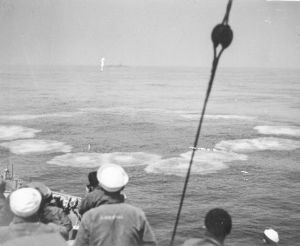Battle of Point Judith facts for kids
Quick facts for kids Battle of Point Judith |
|||||||
|---|---|---|---|---|---|---|---|
| Part of World War II | |||||||
 Sailors aboard USS Moberly firing on U-853. |
|||||||
|
|||||||
| Belligerents | |||||||
| Strength | |||||||
| Sea 1 destroyer 2 destroyer escorts 1 frigate 1 collier Air: 2 blimps |
1 U-boat | ||||||
| Casualties and losses | |||||||
| 12 killed 1 collier sunk |
55 killed U-853 U-boat |
||||||
The Battle of Point Judith was a sea fight between the United States and Nazi Germany during World War II. It happened on May 5 and 6, 1945, near Point Judith, Rhode Island. At this time, Germany was very close to surrendering, and its leader, Adolf Hitler, had already died.
In this battle, American warships and two large airships called blimps worked together. They successfully sank a German U-boat (a type of submarine). This was one of the very last battles of the Battle of the Atlantic, which was a long fight for control of the seas. The SS Black Point, a large ship carrying coal, was sunk at the start of this battle.
Contents
What Happened Before the Battle?
The German U-boat: U-853
U-853 was one of several German submarines sent to operate near the North American coast in early 1945. By May 1945, it was one of only a few U-boats still active in that area. On May 6, it was patrolling the coast near Rhode Island.
The American Coal Ship: SS Black Point
The SS Black Point was a large ship built in 1918. It was a coal ship, meaning it carried coal. During World War I, it served in the US Navy. By World War II, it was known as the SS Black Point. On May 6, 1945, it was on its way to Boston, Massachusetts. It had Navy guards on board to protect it.
The Battle Begins
Germany's Surrender Order
On May 4, 1945, the leader of Germany, Karl Dönitz, ordered all German U-boats to stop their attacks. This was because Germany was about to surrender. Most U-boat commanders followed this order. However, some either did not get the message or chose to ignore it.
The Sinking of the SS Black Point
On May 5, the U-853 was waiting off Point Judith. It spotted the SS Black Point. The U-boat fired two torpedoes, which are underwater missiles. Both torpedoes hit the Black Point. One of them blew off the back of the ship.
Within 15 minutes, the Black Point turned over and sank in about 95 feet (29 meters) of water. It was the last American merchant ship to be sunk in World War II. Sadly, 11 crew members and one Navy guard died. Other ships nearby rescued 34 people.
A rescue ship sent a radio message about the torpedo attack. The US Navy commands in New York and Boston quickly received the message. The closest warships were part of Task Force 60.7. This group included a destroyer called USS Ericsson, two destroyer escorts named USS Amick and Atherton, and a frigate called USS Moberly.
These ships were ordered to immediately start a search and destroy mission against the submarine.
The Hunt for U-853
The first US Navy ships arrived at Point Judith around 7:30 PM. They began searching the area using their Sonar equipment. Sonar uses sound waves to find objects underwater. Just after midnight, they found U-853 resting on the seabed in about 108 feet (33 meters) of water.
The warships attacked the U-boat. After the first attack, oil was seen on the surface of the water. This made some think the U-boat was destroyed. However, the ships kept finding signs of the U-boat, so the attacks continued through the night.
More warships arrived to help. They surrounded the search area to prevent the U-boat from escaping.
Air Support and Final Destruction
By daybreak, two K class blimps, K-16 and K-58, joined the hunt from the air. Blimps are large, non-rigid airships. They helped by finding oil slicks on the water and marking possible locations of the U-boat with smoke and dye. K-16 even attacked with six rocket bombs.
Finally, around 12:07 PM, the Navy command accepted that the U-boat had been destroyed. The long hunt was over.
The Wreck of U-853
Later that same day, US Navy divers found the wreck of U-853 about 130 feet (40 meters) deep. The submarine had been hit twice, causing its pressure hull to break. The pressure hull is the strong inner shell of a submarine that protects the crew from the high pressure of the water. All 55 crew members on board died.
Evidence showed that U-853 was destroyed sometime between midnight and midday on May 6. During the 17-hour hunt, the US warships used 264 Hedgehog bombs and 95 depth charges. These were special weapons designed to sink submarines. The explosions in the shallow water were so strong that at least one US ship was damaged by the shockwaves. Many of the later attacks were aimed at the wreck to make sure it was completely destroyed and to gather proof.

